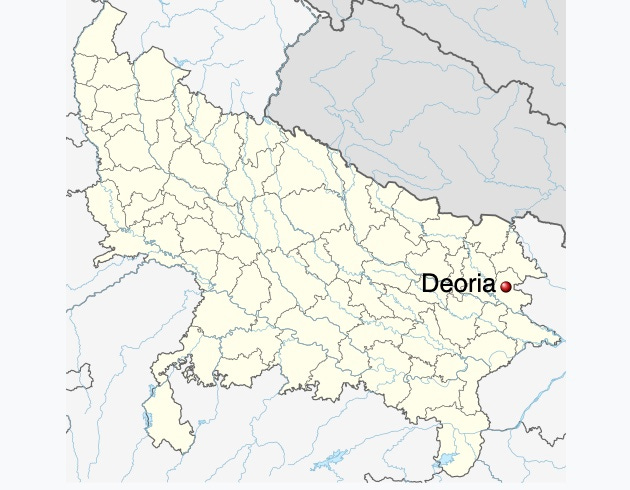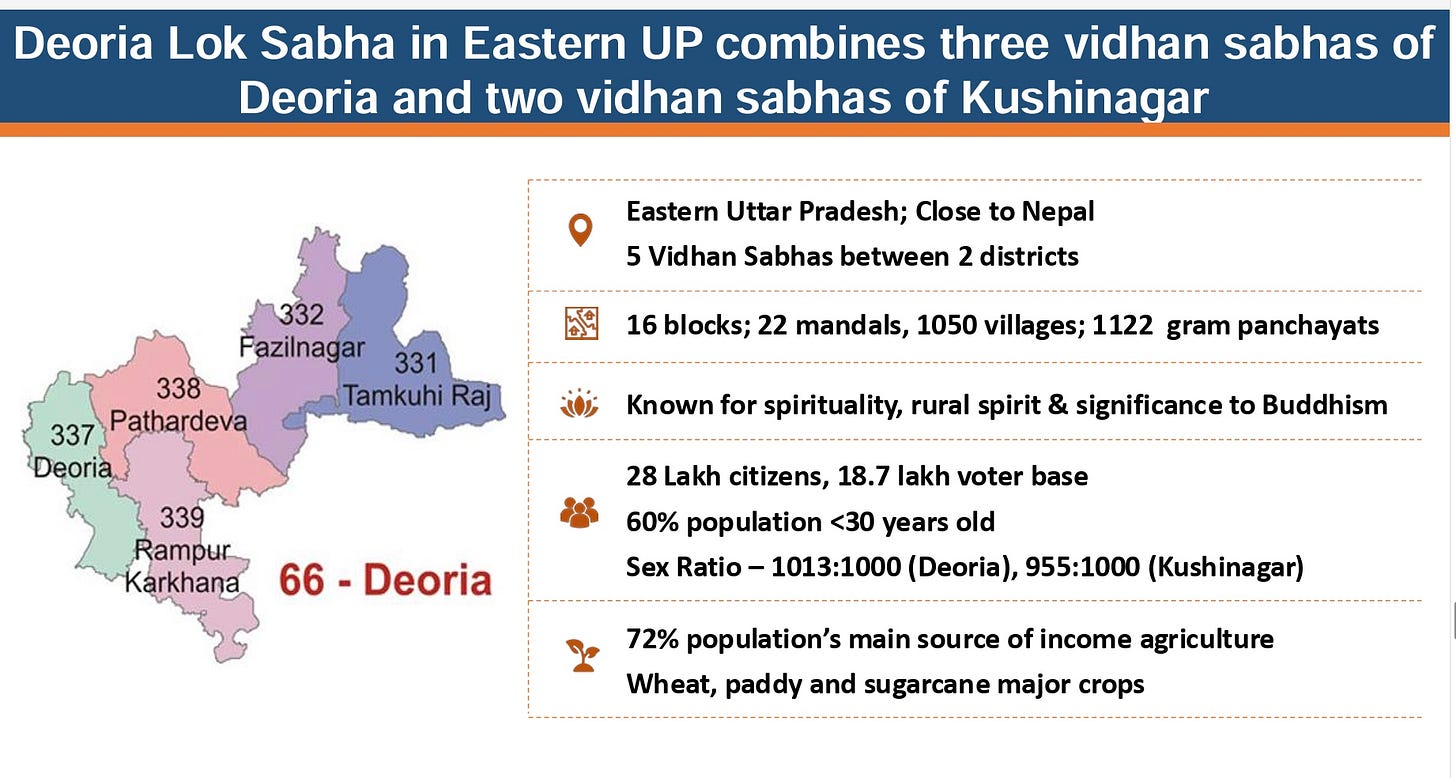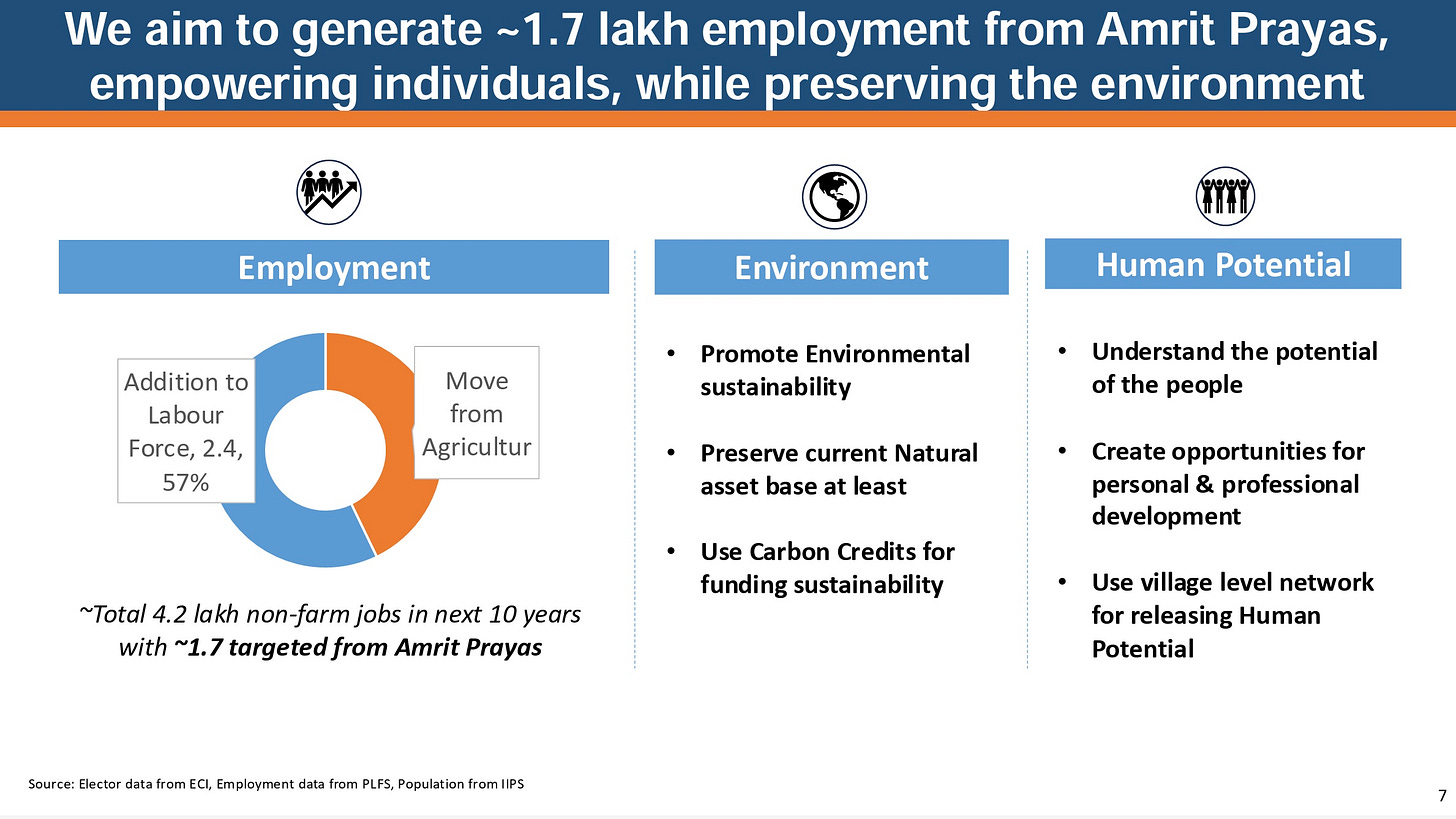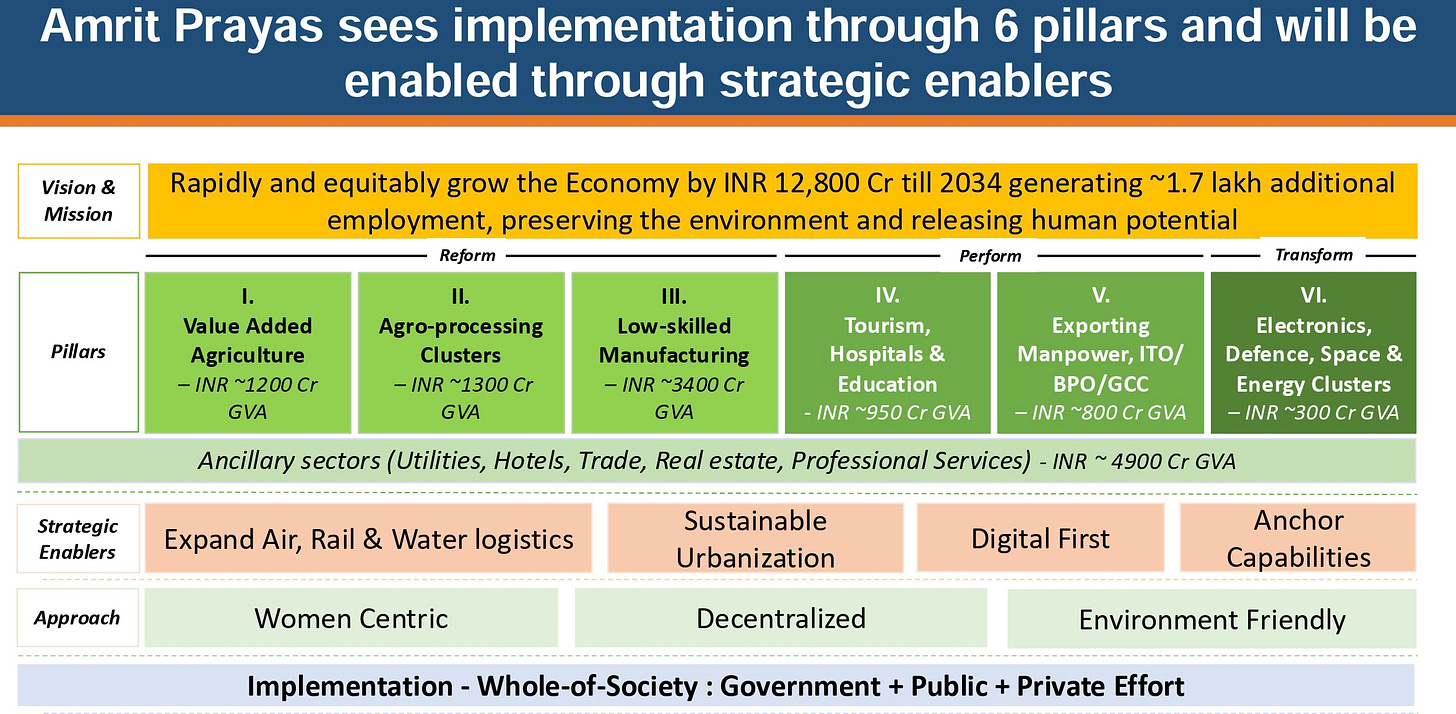The Audacity of Deoria
A backward district in long neglected Eastern Uttar Pradesh comes up with a 10-year plan to evolve into the top tier of the Indian economy. EPISODE #220
Dear Reader,
A very happy Monday to you.
Last week I travelled to Deoria (pronounced as Devaria) in Eastern Uttar Pradesh, a long neglected and backward region, to attend a meeting of the Deoria Development Alliance (DDA) hosted by the local and first-time MP, Shashank Mani Tripathi, of the Bharatiya Janata Party (BJP). The trip was an eyeopener to Bharat’s challenges, tenacity and aspirations.
The MP and his enthusiastic team unveiled a plan to turnaround the local economy without structurally altering its predominantly agrarian structure. Something that is so counterintuitive, given all we know—growth comes with investment in manufacturing.
At the least this plan is ambitious. Located in Eastern Uttar Pradesh and flanked by Gorakhpur, Deoria’s economy, like the rest of the region, is struggling. Given this backdrop, the plan is audacious—the theme of my newsletter this week.
The cover picture is of the attendees converging for a moment of meditation, at the end of the first day of deliberations, at the majestic Banyan tree located in the complex housing a non-profit set up by Shashank Mani years ago in his native village of Barpar.
Happy reading.
Deoria’s Dare
“Where are you going?”, a friend queried when I informed her that I will not be in town for the weekend.
“Deoria!!”, she exclaimed, and then added, “Where in the world is that.”
She is not to blame. Most of us would be similarly culpable.
I am sharing the location of Deoria (pronounced Devaria) in a map of Uttar Pradesh sourced from Wikipedia.
If the first time member of Parliament (MP) Shashank Mani Tripathi has his way with the Deoria Development Alliance (DDA) 10-year plan to turnaround the economy of this Lok Sabha constituency with the assistance of all stakeholders, including the citizens, then Deoria will figure prominently in the national discourse.
It is a tall ask. But, Shashank Mani and his merry band are daring to dream.
Many moons ago, Martin Luther King had a similar “dream” to transform race relations in the United States and empower the disenfranchised African-American community. Undaunted by the circumstances he pressed ahead to grab democratic power for his community. It is now the turn of Shashank Mani to dare the odds similarly.
On the face of it, the blueprint for the turnaround of Deoria is audacious. To my knowledge, it is something that has never been tried earlier and challenges accepted economic wisdom—growing an economy without making the transition to manufacturing.
Simply put, the odds are stacked against the plan. Hence its audacity is staggering.
The Plan
The graphic above, sourced from the DDA plan, shares a quick snapshot of Deoria.
It is flanked by Gorakhpur, a high profile Lok Sabha constituency previously represented by Yogi Adityanath, the current chief minister of Uttar Pradesh, for five consecutive terms ending 2014. Further to the South is Varanasi, the most high profile constituency in the state—ever since PM Modi got elected from there in 2014.
Despite these high profile political eyeballs, the region in general and Deoria in particular have been in a state of neglect. It is not however part of the aspirational district programme launched by the union government in collaboration with the state governments in 2018 to kickstart the economies in 112 districts in the country. Neither is it a high performer. It is in the invisible middle as it were.
Though the demographic distribution—60% less than 30 years old and favourable sex ratio)—favours Deoria, agriculture remains the primary source of income for three-quarters of the population.
The DDA however proposes to alter this status quo that has prevailed for the last seven decades since Independence. The ambition of the project, dubbed Amrit Prayas, to accelerate economic growth is summed up in the graphic below.
As Piyush Jain, a key member of the team put it succinctly: “The best welfare programme is economic growth.”
Similarly, its plan for jobs is as follows:
This ambition will be productionised in the following manner:
The bottomline of the above graphic sums up the spirit of the strategy. Its success rests on all stakeholders, local populace, government (centre and state), civil society and the private sector.
While this strategy is new for us, Shashank Mani has been arguing this for years. It is best captured in his must-read book, Middle of Diamond India.
The book puts the spotlight on the long neglected Tier-2 and Tier-3 districts like Deoria and how they can be transformed by tapping their latent potential.
In a happy coincidence, the District Magistrate assigned to Deoria is a young and accomplished IAS officer Divya Mittal, who like Shashank is an IIT Alumnus. I had been following her on X for her compelling tweets and grassroots work. It was heartening to see her energy and enthusiasm in person on the final day of the event at Deoria.
Another favourable factor is that the state and the union government are led by the Bharatiya Janata Party (BJP). This “double-engine” will potentially ensure that the usual red tape will not bind the aspirations of Deoria.
Deoria’s Aspirations
Our visit also entailed meetings with a clutch of local entrepreneurs that are being seeded and supported by the Jagriti Enterprise Centre, a non-profit set up by Shashank Mani in Deoria.
The collage above captures the range of entrepreneurs that are popping up in the constituency, despite all the constraints. Imagine how their abilities will scale when the ecosystem becomes more conducive. Every participant who fanned out to meet these entrepreneurs had only good stories to share. But the main takeaway was their unbridled enthusiasm and disdain for the challenges.
As they stars are aligned. The success of Deoria can potentially generate a template that could be emulated by other districts in middle-India who also struggle against similar odds. Remember, the ambitions of Viksit Bharat rest on the shoulders of Middle India.
As they say, it is time to dream big.
Recommended Viewing
Sharing the latest episode of Capital Calculus. (Please note that Capital Calculus has moved to a new home (stratnewsglobal.tech) within StratNews Global. This relocation will take a bit of getting used to—bear with me.)
Later this week, 2 April, the United States will roll out the next phase of its tariff strategy when it imposes reciprocal tariffs on all countries, including India. Countries fear that this could unleash another round of disruption and roil the world economy, which is only just recovering from the covid-19 pandemic. How will this impact India?
To answer these vexing questions I spoke to T S Vishwanath, a trade expert. According to Vishwanath, this is an opportunity India should seize to roll out the much needed reset of domestic competitiveness. His response is in contrast to the popular narrative, which has been arguing that it is doomsday for the Indian economy.
Do watch. Sharing the link below.
Till we meet again next week, stay safe.
Thank You!
Finally, a big shoutout to Premasundaran and Gautam for their informed response, kind appreciation and amplification of last week’s column. Once again, grateful for the conversation initiated by all readers. Gratitude to all those who responded on Twitter (X) and Linkedin.
Unfortunately, Twitter has disabled amplification of Substack links—perils of social media monopolies operating in a walled garden framework. I will be grateful therefore if you could spread the word. Nothing to beat the word of mouth.
Reader participation and amplification is key to growing this newsletter community. And, many thanks to readers who hit the like button😊.










In 2014 PM Modi expressed his commitment to a "Swachh Bharat " and although the process is not yet complete, it is important to have a vision, intent and a plan for achieving the goal. So it seems like Deoria is now a work in process. The challenge for India is to make progress in rocket science, world class urbanization and at the same time to upgrade the economic progress of it's tier 3 and 4 towns. To stick with agriculture as the base and diversify into agro based industry and small scale industries is a good idea. India with the largest population, should continue to be self sufficient in food and also be a major food exporting country. The future of agricultural produce is quite bright in the long term, in my opinion. So best of luck Deoria and thanks Anil for sharing a very interesting article. 👍
Deoria can do with some more eyeballs on the effort being made by Shashank. Your article is very helpful in this regard. I am happy you went again. The young MP has not let us down. 😄